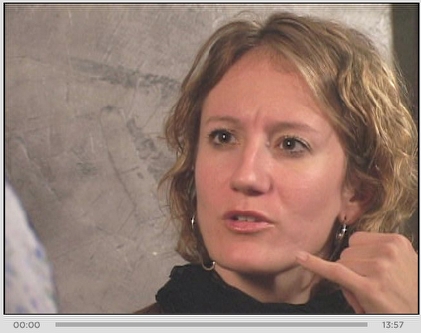This ideas in this post are based on conversations with Bernie Hogan and should be interpreted as the production of our co-thinking.
All too frequently, someone makes a comment about how a large number of Facebook Friends must mean a high degree of social capital. Or how we can determine who is closest to who by measuring their email messages. Or that the Dunbar number can explain the average number of Facebook friends. These are just three examples of how people mistakenly assume that 1) any social network that can be boiled down to a graph can be compared and 2) any theory of social networks is transitive to any graph representing connections between people. Such mistaken views result in broad misinterpretations of social networks and social network sites. Yet, time and time again, I hear problematic assumptions so let me start with some claims:
- Not all social networks are the same.
- You cannot assume network transitivity.
- You cannot assume that properties that hold for one network apply to other networks.
To address this, I want to begin by mapping out three distinct ways of modeling a social network. These are not the only ways of modeling a social network, but they are three common ways that are often collapsed in public discourse.
Sociological “personal” networks. Sociologists have been working hard to measure people’s personal networks and much of the theory of social networks stems from analysis done on these networks. Different scholars have taken different approaches to measuring personal networks, but, most stereotypically, this takes the form of a clipboard and pencil as a young grad student queries an individual to recall who they talked to yesterday and indicate who they would lend money to or call when they are having an emotional breakdown. On classic measurement survey is an appendix in the back of Claude Fischer’s “To Dwell Among Friends.”
Most sociological theory stems from analyses of these personal networks. Social capital, weak ties, homophily, … all of those theories you’ve heard about are based on personal networks. Given that these are typically measured by eliciting people’s understandings of certain categories (e.g., “friend”), there’s a strong overlap between everyday language around social networks and the categories being measured.
If you’re a sociologist talking to anyone other than sociologists, you would probably speak of personal networks as the golden standard, the baseline truth. Of course, if you were being honest with yourself or your colleagues, you will note that these measurements have their methodological flaws and biases which is why the scales for measuring personal networks haven’t stabilized and why scholars still struggle with the best ways to elicit meaningful information from people being surveyed.
Behavioral social networks. Behavioral social networks are the networks derived from encounters between individuals. In their efforts to measure personal networks, sociologists have often tried to get people to manually document encounters with others through diary studies. With new technologies in place, folks have gone on to generate behavioral social networks through the traces people leave behind. For example, a record of someone’s email exchanges provides a handy accounting of that individual’s behavioral network. New technologies introduces new opportunities for measuring behavioral networks. Many genres of social media let us see who communicates with who. GPS technologies let us see who shares physical space.
Behavioral social networks provide valuable insight into people’s practices and interactions, but they do not confer meaning. This is not to say that they don’t have value. I would love to find the strangers that I regularly share space with as I traverse Boston. But we cannot assume that these are my friends or acquaintances. Yet, there seems to be a tendency (especially among geeks of all stripes) to overlay meaning-laden terms on top of these networks, to assume that high connectivity means friendship. This is where trouble often arises. Just because I spend a lot of time with my physical therapist does not mean that she is more important than other people in my network who I see less frequently.
The other difficulty in measuring behavioral social networks is that, at least to date, we measure distinct channels of connection. This complicates our ability to do meaningful comparison across people. If I use AIM as my primary way of keeping in touch with Person A and email as my primary way of keeping in touch with Person B and you only look at one medium, you get a distorted picture of who I communicate with. As communication channels proliferate, this only gets messier. So even when we talk about behavioral social networks, we have to talk about them in across a particular channel.
Publicly articulated social networks. Articulated social networks are the social networks that you intentionally list. In some senses, this is what sociologists are eliciting, but people also articulate their social networks for other purposes. Address books and buddy lists are articulated social networks. So too are invitation lists. Most recently, this practice took a twist with the rise of social network sites that invite you to PUBLICLY articulate your social network.
At this point, I would hope that most of us would realize that Friends != friends. In other words, who you connect to on Facebook or MySpace or Twitter is not the same list of people that you would say constitute your closest and dearest. The practice of publicly articulating one’s social network can be quite fraught because there are social costs to the process of public articulation. Issues of reciprocity emerge and people find themselves doing a lot of face-work to navigate the sticky nature of having to account for their social relations in a publicly accountable way. Thus, the list of who you might list as a Friend is often a mix of friends, acquaintances, family members, people from your past, fans, professional colleagues, familiar strangers, and people you don’t particularly like but don’t want to offend. Oh and the occasional celebrity you think is interesting.
Relating Different Social Networks
These networks are NOT the same. Your mother may play a significant role in your personal network but, behaviorally, your strongest tie might be the person who works in the cube next to you. And neither of these folks might be links on your Facebook for any number of reasons.
Our instinct then is to ask: which is the “real” social network? Frankly, it depends on who you ask. Your mother may be cranky that you don’t talk to her as often as your colleague and she may resent your refusal to Friend her on Facebook, but this doesn’t mean you love her any less. Of course, this doesn’t stop her from thinking you don’t love her. If we’re trying to understand emotional affinity, the behavioral and publicly articulated social networks aren’t particularly helpful. But if you’re mother thinks that time is not only a proxy for emotional depth but a proof of it, your behavioral social network might really upset her. (Note: behavioral social networks have gotten people into trouble in the past. See Cobot.)
The truth of the matter is that there is no “real” social network. It all depends on what you’re trying to measure, what you’re trying to do with those measurements.
We do ourselves an intellectual disservice when we assume that these different types of networks are interchangeable or that studying one automatically tells us about another. Most scholars get this, even when they’re quoted out of context by journalists to suggest otherwise (see Cameron Marlow). But I get the sense that a lot of journalists, marketers, advertisers, politicians, and everyday folks don’t. This is a problem.
Those who treat different social networks interchangeably project properties onto the network they’re analyzing that don’t hold. People aren’t inherently cool or connectors because they have a lot of Friends on a social network site. Bus drivers and waitresses are much more likely to encounter more new people on a daily basis than executives, but this doesn’t mean that they have more social capital. People who email regularly do not necessarily have strong tie strength.
This is not to say that structural information in behavioral social networks or publicly articulated social networks may not work as a proxy for personal networks. Perhaps the networks derived from a particular social media tool or through a particular channel of communication do actually provide insight into a person’s personal network. There are great ways to empirically test this hypothesis involving the combination of structural analysis and interviewing. But you cannot simply assume that they are meaningful proxies just because they are both social networks.
There are also many opportunities for new research when we tease out different types of social networks. What if we overlay the different types of social networks? Can we get a better sense of how someone manages their social network? Can we see new structural properties that give us new insights into how people connect, share information, gather support, etc.? So many possibilities!
I’m super excited that so many people from so many fields are getting interested in social networks, but I’m also scared that there are a lot of assumptions flying around that make it difficult to make sense of people’s contributions to this emergent field. Increasingly, I see sociologists and computer scientists and mathematician and economists outright dismiss work outside of their field as “wrong.” I think that part of the problem is that we’re each failing to account for what we can and cannot say based on the types of analysis we’re doing. And I think that we often talk past one another because we’re all talking about social networks but we’re talking about different social networks. In accounting for three types of social networks here, I’m not trying to be all-inclusive, but I am trying to point out that there are differences and that we cannot assume transitivity either in terms of structure or theory. If we can find a way to better identify what kinds of social networks we’re talking about and when and where what theories apply, I think that we’ll go a long way in bridging different intellectual discourses.
 But this is going to force people to think about these issues. And the more people think about it, the more they actively try to control what’s going on. (Of course, we need Facebook to stop taking controls away from people, but that’s a different story.)
But this is going to force people to think about these issues. And the more people think about it, the more they actively try to control what’s going on. (Of course, we need Facebook to stop taking controls away from people, but that’s a different story.) 